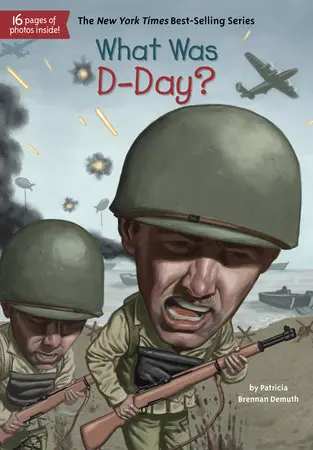

“What Was D-Day?” by Patricia Brennan Demuth
Just days ago, June 6, 2018, marked the 74th Anniversary of D-Day.
In the dark hours of that morning 74 years ago, ships in the numbers of about 5,000 in “all shapes and sizes” along with ….more than 155,000 soldiers on board – mostly American, British and Canadian were sailing across the English Channel.”
Our children should know why these soldiers were there.
As we get further and further from that date and its veterans are passing away at the rate of about 450,000 a year, in about twenty years, its participants and their stories will have passed from memory.
And we, as parents and educators, cannot allow that to happen.
The New York Times best selling series entitled, “What was?” and “What is?” can do much to stem the tide of the disappearance from memory of events that happened long before children of picture book age were born.
It is important for them to know the relevance and significance of these events in our time, the sacrifices that were related to them, and their import for our children’s future, if their history is ignored, or erased as irrelevant.
On D-Day, over 160, 000 Allied soldiers, and as Ms. Demuth terms allies, they are “friends joined together for a cause,” came by air and sea to come upon the beaches of Normandy in France.
It was the start of the largest invasion force in history, set in motion to stem the Nazis invasion that had stormed Europe and was continuing its onslaught…unless.
Young readers will learn in eleven chapters, plus a Timeline and photos, the essentials of World War ll that had been fought up to the point of D-Day, for five years. Nearly all of Europe had at this point been dominated by Germany.
Up to the time of D-Day, almost no Allied troops were on the ground in Europe.
D-Day is a code word for the “day of any major military attack?”
D-Day was the beginning of the end of World War II.
I recently read a parent review online of this book. This parent, several years ago on the 71st anniversary of D-Day was taking her children to Normandy to see where the events of D-Day unfolded. Her children were between the ages of 5 and 11.
This was the age appropriate book that she chose to read as they journeyed there.
There are the fact-filled events, along with 16 pages of photos; for to a child, a single picture can speak volumes.
One singular photo of the sight, taken from above is of hundreds of paratroopers dropping from planes from the sky over Normandy at night. And it is just one of the many pictures that may provoke discussion.
And if it does, young readers will learn from “What Was D-Day?” that 20,000 men parachuted from these planes. The terrible toll taken that day was that “one out of five of these brave men were killed, wounded or taken prisoner.” And yet, in spite of these losses, paratroopers did manage to take over “key exit bridges and roads.”
Your young readers great grandfathers probably were either directly involved or, in some other way, affected by World War II. Certainly many family members were touched in some way by this day and the days that followed until the war’s end in Europe on May, 7, 1945.
Maybe this book is a way to focus discussion in your family, if they are open to it.
Ms. Demuth has done a fine job here with a difficult subject for young readers.
And yet, it is a very important event that must be shared with children.
Life can be difficult.
It sometimes involves hardship and sacrifice that are thrust upon us.
Please let your young readers know about this Greatest Generation and its profound ability to navigate and not avoid hardship and sacrifice, especially on D-Day.
They, and D-Day, are a model of both for the next generation of citizens on how to face adversity.
On June 6, 2014, on the 70th Anniversary of D-Day, President Obama spoke of that day in these words:
The “course of history” hung on this” sliver of sand [ at Normandy], he said. “Our victory in [ World War ll ] decided not just a century, but shaped the security and well-being of all posterity.
“What is D-Day?” is a guidebook for young readers that should be in every child’s library before we approach its 75th Anniversary next year.
